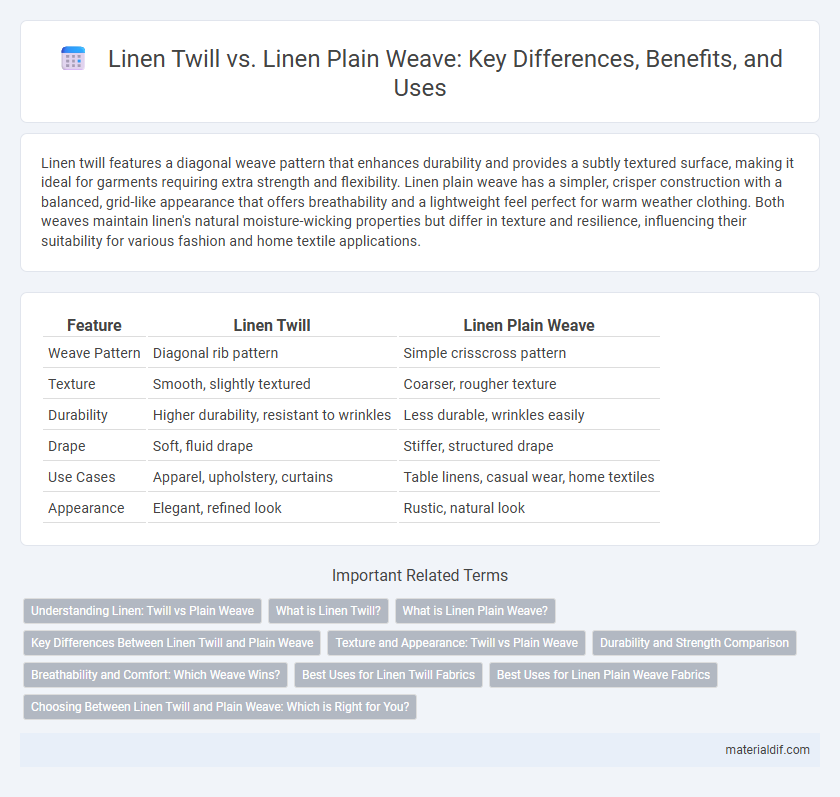Linen twill features a diagonal weave pattern that enhances durability and provides a subtly textured surface, making it ideal for garments requiring extra strength and flexibility. Linen plain weave has a simpler, crisper construction with a balanced, grid-like appearance that offers breathability and a lightweight feel perfect for warm weather clothing. Both weaves maintain linen's natural moisture-wicking properties but differ in texture and resilience, influencing their suitability for various fashion and home textile applications.
Table of Comparison
| Feature | Linen Twill | Linen Plain Weave |
|---|---|---|
| Weave Pattern | Diagonal rib pattern | Simple crisscross pattern |
| Texture | Smooth, slightly textured | Coarser, rougher texture |
| Durability | Higher durability, resistant to wrinkles | Less durable, wrinkles easily |
| Drape | Soft, fluid drape | Stiffer, structured drape |
| Use Cases | Apparel, upholstery, curtains | Table linens, casual wear, home textiles |
| Appearance | Elegant, refined look | Rustic, natural look |
Understanding Linen: Twill vs Plain Weave
Linen twill fabric features a distinctive diagonal rib pattern that enhances durability and drape compared to linen plain weave, which has a simple crisscross pattern offering a lighter, more breathable texture. Twill weave linen is ideal for garments or home textiles requiring strength and resistance to wrinkles, while plain weave linen is preferred for its crispness and cooler feel in warm climates. Understanding these differences helps in selecting the appropriate linen fabric based on usage, durability, and aesthetic preferences.
What is Linen Twill?
Linen twill is a type of linen fabric characterized by its distinctive diagonal weave pattern, which offers greater durability and a smoother texture compared to plain weave. This weaving technique creates a fabric that drapes well and resists wrinkles, making it ideal for garments like trousers and jackets. Linen twill provides enhanced strength and a subtle sheen, distinguishing it from the simpler, grid-like structure of linen plain weave.
What is Linen Plain Weave?
Linen Plain Weave involves a simple crisscross pattern where the weft thread alternates over and under each warp thread, creating a tightly woven fabric known for durability and breathability. This weave produces a smooth and even surface, making it ideal for lightweight clothing and home textiles. Textile experts favor Linen Plain Weave for its classic texture and ability to maintain strength even with frequent laundering.
Key Differences Between Linen Twill and Plain Weave
Linen twill features a diagonal weave pattern that provides greater durability and a softer drape compared to linen plain weave, which has a simple crisscross pattern offering a more textured and breathable fabric. The twill weave's characteristic diagonal ribs make it more resistant to wrinkles, making it suitable for clothing and upholstery with higher wear demands. Plain weave linen is lighter and more crisp, ideal for summer apparel and home textiles where airflow and comfort are prioritized.
Texture and Appearance: Twill vs Plain Weave
Linen twill features a diagonal ribbed texture, creating a more pronounced and durable surface compared to the flat and smooth appearance of linen plain weave. The twill weave enhances depth and sheen, lending a richer visual interest, whereas plain weave offers a crisp, classic look with a uniform texture. Twill's texture tends to be softer and drapes better, while plain weave remains stiffer and more breathable.
Durability and Strength Comparison
Linen twill exhibits greater durability and strength compared to linen plain weave due to its diagonal rib pattern, which enhances fabric resistance to tearing and wear. The twill weave's interlacing structure distributes stress more effectively, making it ideal for heavy-use applications and garments requiring longevity. Linen plain weave, while breathable and lightweight, tends to be more prone to fraying and less robust under repeated strain.
Breathability and Comfort: Which Weave Wins?
Linen twill features a diagonal weave that enhances durability but slightly reduces breathability compared to linen plain weave, which offers a looser, more open structure for superior airflow and moisture-wicking. Plain weave linen excels in comfort during hot weather due to its lightweight and breathable nature, making it ideal for summer clothing and bedding. For those prioritizing airflow and cool comfort, linen plain weave is the optimal choice, while linen twill provides added strength without significantly compromising comfort.
Best Uses for Linen Twill Fabrics
Linen twill fabrics, characterized by their distinctive diagonal weave pattern, offer enhanced durability and a softer drape compared to plain weave linen, making them ideal for garments subjected to frequent wear such as trousers, jackets, and structured dresses. Their resistance to wrinkles and creases supports applications in tailored apparel and home textiles like upholstery and heavier curtains. Linen twill's heavier weight and texture provide both aesthetic appeal and functional strength, perfect for stylish yet practical clothing and decor items.
Best Uses for Linen Plain Weave Fabrics
Linen plain weave fabrics are ideal for lightweight clothing, table linens, and curtains due to their smooth texture and breathability. Their simple over-under weave provides durability and resistance to wear, making them suitable for everyday use and home textiles. The plain weave structure enhances linen's natural moisture-wicking properties, ensuring comfort in warm weather applications.
Choosing Between Linen Twill and Plain Weave: Which is Right for You?
Linen twill features a distinctive diagonal weave that offers enhanced durability and a softer drape compared to the classic linen plain weave, which showcases a simple, crisp, and breathable texture ideal for lightweight garments or home textiles. Choosing between linen twill and plain weave depends on the intended use: twill is perfect for items requiring strength and wrinkle resistance, such as pants or jackets, while plain weave suits airy shirts and curtains prioritizing breathability. Consider fabric weight, texture, and end-use when selecting linen twill or plain weave to ensure optimal comfort and performance.
Linen Twill vs Linen Plain Weave Infographic

 materialdif.com
materialdif.com